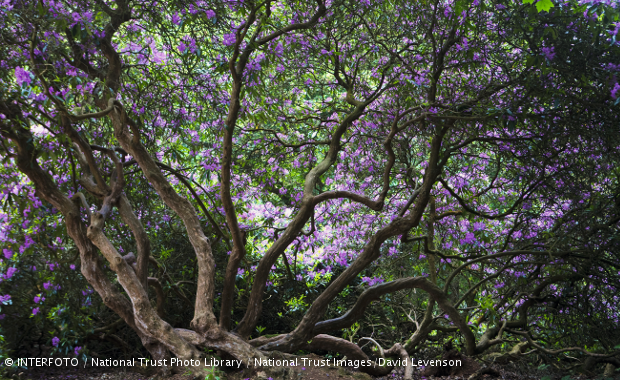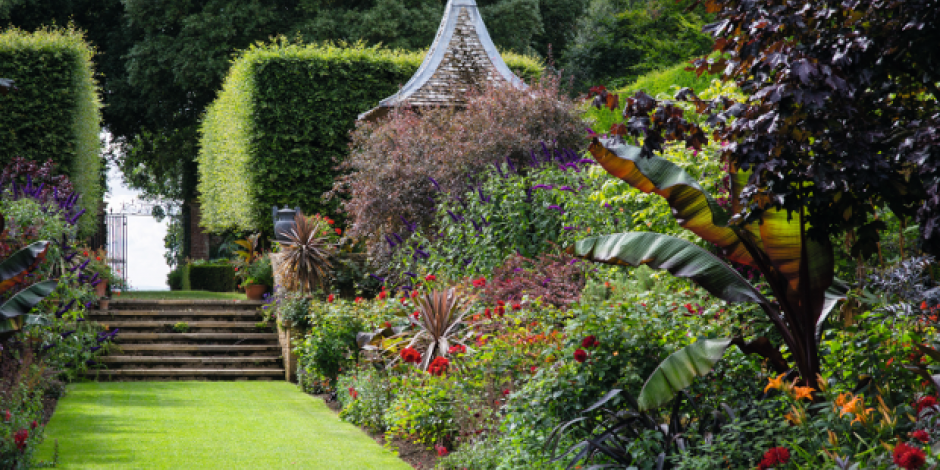I come from a family of gardeners. My grandmother, uncles, aunts, cousins are — or were — never happier than when, in the words of writer Rudyard Kipling, “to grubgrabengrubbing weedsUnkrautweeds from gravelSchotter-, Kies-gravel paths with broken dinner knifeMenümesserdinner knives”.
My father was passionate about plants. Our English garden, surrounded on two sides by a red-brickBackstein-red-brick wall and dottedgesprenkelt; hier: voll vondotted with fruit trees left over from the orchardObstgartenorchard it had once been, was a jungle of the loveliest floraPflanzenweltflora. A photo taken on my fifth birthday shows me posing in front of a flame-coloured azalea (Coccinea speciosa). Summer family lunches were eaten outside in the shade of a red-barked strawberry tree (Arbutus x andrachnoides). And at Christmas, the table was decorated with the sweet-smelling flowers of a Mahonia japonica that came from our garden.
Sadly, I do not have my father’s green fingers, but I greatly appreciate English horticulture. So may I invite you to join me, as I visit three of England’s loveliest gardens? Wellington boot (UK)GummistiefelWellington boots won’t be necessary.
Sheringham Park — to gazeblickengazing from the gazeboAussichtspunkt, Aussichtspavillongazebo
The word “park” has its roots in the Latin parricus meaning “enclosure”. There is no feeling, however, of being enclosed at Sheringham Park. The sprawlingausgedehnt, wucherndsprawling grounds are set between low hills on the north Norfolk coast. It’s a very English kind of paradise.
The park and house are the work of the landscape designer Humphry Repton (1752–1818). Repton, who created the term “landscape gardening”, took on more than 400 landscaping commissionAuftragcommissions during his career.
He had already made a name for himself when, in 1811, a wealthy young landowner, Abbot Upcher, asked him to design a park and house on lands that Upcher had bought next to the village of Upper Sheringham. Repton, who was familiar with the area, was happy to accept the commission.
For every project, the famous landscape gardener created a Red Book — so called because it was covered in red leather. This contained the plans for the buildings and garden designs, with drawings and text.
At Sheringham, Repton, working together with his son John, designed a two-storeygeschossigstorey house with a colonnadeSäulengang, Wandelgangcolonnade on the south side and surrounded by woodland, orchards, a kitchen garden and open parkland. Much of what the visitor sees today follows Repton’s initial plans.
Only a few steps from the car park is the start of the ramblerSpaziergänger(in), Wanderer, WanderinRamblers Route around the grounds of Sheringham. It is one of three walks that are marked on a map provided by the National Trust, which runs the property. It will take me on a circular walkRundwanderwegcircular walk past Sheringham Hall. I admire Himalayan birchBirkebirches, fine old beechBuchen-beech trees and some bird cherry treeTraubenkirschbaumbird cherry trees before turning off into the Wild Garden.
This part of the park is dominated by rhododendrons. I climb on to a small viewing platform and look down on a carpet of purple, orange, white and pink blossomBlüteblossoms, although they are now no longer at their best. It’s late June. May is the month to enjoy these flowers. Rhododendrons are native to the Alps, Spain, Portugal, Turkey, India, China and North America. The first recorded cultivation of a rhododendron in Britain (R. hirsutum) was in 1650. By the early 19th century, British plant hunters were being sent around the world to find exotic shrubStrauchshrubs and plants, including new rhododendron varieties, which were then sold on a flourishingflorierend, blühendflourishing market for gardeners. E. H. Wilson (1876–1930), one of the best-known British plant hunters, travelled to China in 1900 to bring back seedlingSämling, Jungpflanzeseedlings of the handkerchief treeTaschentuchbaumhandkerchief tree (Davidia involucrata), which has large white bractDeckblatt, Tragblattbracts that look like waving handkerchiefs around each flower. He came home with a specimen — there is one here at Sheringham — but also with many other exotic plants, including some of the rhododendrons I can see below me now, such as the rhododendrons ambiguum, calophytum and decorum.
The Ramblers Route now leads me through open parkland to a small temple on a hill, from where I can see Sheringham Hall surrounded by trees and the sea beyond. This is what I have come for: the combination of calm English parkland edgedgesäumtedged with a restless sea. Perhaps, though, seen high up from a gazebo, which lies further on between the house and the sea, I will get an even better view.
As Sheringham Hall is privately owned and it is not possible to look inside the building, I climb straight to the top of the gazebo. In the distance lies the cool blue North Sea. In between are parkland and fields, punctuatedunterbrochenpunctuated to the left by a white millMühlemill and by red farm buildings to my right. In the middle distance, a small train to chugtuckernchugs along a single-trackeingleisigsingle-track line. I lean on the balustradeGeländer, Brüstungbalustrade and enjoy this perfect vistaAusblickvista.
Landscaped parks like the one at Sheringham, which became fashionable in the 18th century, were created for a wealthy elite. peasant farmerKleinbauerPeasant farmers were less happy about this trend. Many had already been to drive offvertreibendriven off the land, as the common pastureGemeindehutung, Weidecommon pastures they relied on were claimed by landowners who to encloseeinfrieden, umgebenenclosed the fields with high hedgeHeckehedges.
When landscaping by gardeners such as William Kent (1685–1748), Lancelot “Capability” Brown (1716–83) and Humphry Repton began, it created additional hardshipHärte, Nothardship for the rural poor. A designer’s plans might mean flooding fields and villages to create ornamental lakes, or turning common land into private woodland.
Later, as I sit in my car with the door open, drinking a cup of tea, I read the booklet on Sheringham provided by the National Trust. I am pleased to find that there is no mention of displacedverdrängt, vertriebendisplaced persons.

gravelKies, SchotterHidcote Gardens — “tormentingly perfect”
A group of visitors are seated in a semicircle on folding chairs on a small round lawn, while a gentleman from the National Trust talks to us about the history of Hidcote Gardens. Our speaker has an excellent sense of humour, but the audience’s response to his presentation is rather mutedverhaltenmuted. Perhaps, like me, the other visitors are disappointed to discover that the creator of this quintessentiallyvollkommen, durch und durchquintessentially English garden, Lawrence Johnston, was actually American.
Major Lawrence Johnston (1871–1958) was born into a wealthy family of bankers and industrialists. He came to England as a young man, studied history at Cambridge, became a naturalizedeingebürgertnaturalized Brit and served in the Second Boer WarZweiter BurenkriegSecond Boer War (1899–1902). On his return from South Africa, Johnston joined the Royal Horticultural Society and began reading up on gardening. In 1907, the property Hidcote Bartrim in Gloucestershire came up for sale. The estateAnwesenestate, located on a windy uplandAnhöhe, Plateauupland in the Cotswolds, included a manor houseGutshausmanor house, a village of a dozen houses and more than 280 acreMorgen (4.047 m2)acres of land. Johnston persuaded his mother, who to hold the purse stringsdie finanzielle Kontrolle habenheld the purse strings, to pay the £7,200 asking price.
From then on, with only one interruption — while serving in the First World War — Johnston devoted his life to creating what his friend, the American writer Edith Wharton, described as a “tormentinglyquälendtormentingly perfect” garden.
Johnston was inspired by the Arts and Crafts movement. One of the books he read was Thomas H. Mawson’s The Art and Craft of Garden Making. Mawson favoured a garden design based on a series of compartmentFach; hier: Raumcompartments, or “rooms”, separated from each other by hedges or trees. Each room allows views into other rooms, creating the effect of walking through an openair house. As suggested by Mawson, the gardens at Hidcote, which cover an area of around 10 acres, are made up of a series of compartments.
I start my tour close to the manor house at the Great Lawn. It’s a long, plaineinfach, schlichtplain green oblongrechteckigoblong surrounded by a high yew hedgeEibenheckeyew hedge, with enormous trees and a raised platform at one end. The atmosphere is calm and formal. As I stand at the edge of the Great Lawn, I can see the Old Garden a little to the left, where the climbing yellow rose “Lawrence Johnston” grows. I decide to walk straight ahead through a small garden called the Circle and turn right so that I can see one of Hidcote’s most famous views.
Ahead of me are two long gardens. The first, Red Borders, has a narrow green stripStreifenstrip of grass with red flowers and shrubs along each side. At the moment, rubyrubin-ruby-red roses are in bloom, mixed with yucca plants and other reddish foliageLaub, Blattwerkfoliage. In September, a highlight of this garden is a red Verbena also named after Johnston. Beyond that, set slightly higher, is the stiltStelze: hier: in Form geschnittener BaumStilt Garden, where there is a row of hornbeamHagebuchehornbeams on each side of the lawn. The lower parts of their trunkStammtrunks are cut clean of branches, creating a stilt-like effect. It is the view beyond, though, that makes this place so special. The wrought-ironschmiedeeisernwrought-iron Heaven’s Gate marks the end of the gardens, with the land beyond it falling away sharply enough to create the illusion that this gate really marks the entrance to heaven.
In the early 1920s, Johnston became interested in plant hunting and went on expeditions to the Swiss Alps, South Africa, Kenya and China. Some of the plants he brought back still grow at Hidcote. The yellow Hypericum x hidcoteense “Hidcote” was developed from a plant that he brought back from Mount Kilimanjaro, and he introduced a lavender plant to his garden that he had found in France — now known as the Lavendula “Hidcote”.
I wander on from garden to garden, to dipeintauchendipping my hands into the green waters of the Bathing Pool, where the famous blue Himalayan poppyMohnpoppy (Meconopsis grandis) is at home, before reaching an area on the edge of the property called the wildernessWildnisWilderness. The sprawling shrubs, patch of grassGrasflächepatches of grass and overhanging trees are not truly wild, but they do create the effect Mawson recommended: spaces close to the house should be formal in style, with those further away becoming increasingly naturalistic, so that finally there is a sense that the garden melts into the landscape.
Even on a weekday, the place is crowded — a swarmSchwarm, Mengeswarm of tourists from the US on a lawn here, a group of Japanese ladies planted around a flower bed there. What would Johnston have said about the thousands of garden lovers who make the pilgrimageWallfahrt, Pilgerfahrtpilgrimage to Hidcote? Having created a little paradise here on earth, he showed that he was happy to share it by asking the National Trust to take it over and open it to the public.
The Beth Chatto Gardens — painting with plants
In her 1978 book The Dry Garden, plantswoman and gardener Beth Chatto (1923– 2018) wrote: “It sounds so obvious, but is worth stating I think, that I find it best to plant plenty of something that looks good most of the time rather than struggle to keep alive plants which at best only accentuatehervorhebenaccentuate the fact that what you have to offer them is not what they need.” Working on this principle, Chatto created an inspirational garden on the wastelandBrachlandwasteland of a former fruit farm out in a lonely corner of East Anglia.
When Chatto began working on her land in 1960, ecological gardening was not yet popular, and the term “climate change” had not been invented. Yet, Chatto was convinced of the importance of sustainablenachhaltigsustainable planting. On the approximately seven-acre plot, she had dry, dampfeuchtdamp, wet and shady conditions, all of which would need different plants. An additional challenge was the lack of rainfall. East Anglia is the driest landscape in Britain.
Chatto was lucky to have the support of her husband, Andrew, an amateur ecologist, who spent many years researching the origins of plants and their natural habitats. He gave her advice on which plants would survive where.
I visited Beth Chatto’s gardens as a child with my parents, but now, as I drive out across the Essex countryside to rediscover this place, I notice just how empty — almost desolate — the landscape is. At some point, I begin to doubt that I will ever find the garden or, when I do, that it will be worth a visit. Finally, I see a sign for the village of Elmstead Market and, just a mile or so south-east of it, I find the Beth Chatto Gardens.
Having arrived, it takes no more than a look at the first of the gardens, created on gravel, to remind me that this is a very special place.
The small Gravel Garden, formerly a car park, is home only to plants that never need to be watered. Chatto compared it to “gardening on the beach”. Between windinggewundenwinding pebbleKieselsteinpebble paths, which were inspired, she says, by a dry riverbed, there are groups of plants in shades ranging from paleblass-, hellpale grey to deep green, with scentDuftscents and colour provided by plants such as lavender, flowering grasses, which add gracefulelegant, anmutiggraceful movement, and — my favourite — a great cloud of rose campion (Lychnis coronaria), the small red-purple flowers glowing on their silver-green stemStielstems. Looking at the big white heads of Allium nigrum and the delicate mauvemalvenfarbenmauve flowers of Parahebe perfoliata, it is hard to believe that the gravel garden has only ever been watered by rainfall.
I walk on to the next garden, where a green lawn with borders dips away from me down to a pondTeichpond. What was once just a muddyschlammigmuddy hollowVertiefunghollow, kept damp by local springQuellesprings, is now a series of ponds. The water’s edge is decorated with large-leaved Gunnera manicata — its strange brush-like flowers adding an exotic note — and by tall irisSchwertlilieirises and feathery-flowered astilbePrachtspiereastilbe.
Further on, at the edge of the property, is the Woodland Garden. On the night of the 15–16 October 1987, Britain was hit by a violent storm — now known as the Great Storm of 1987. Winds of up to 190 km/h caused damage in many parts of Britain, including Chatto’s garden.
Her plan had been to let the woodland develop by itself. Because so many of the trees had been brought down by the storm, however, she decided to plant new ones, but with her own understoreyUnterholzunderstorey. Now, instead of elderberryHolunderbeereelderberries and brambleBrombeerstrauchbrambles beneath the trees, Chatto planted bluebellGlockenblumebluebells and primrosePrimel, Schlüsselblumeprimroses. It is a shady, relaxed space. Not obviously structured, it forms a contrast to the more painterlymalerischpainterly composition that defines the rest of her gardens.
Chatto was the first to acknowledge the influence of painting on her work. A friend of the post-Impressionist artist and gardener Sir Cedric Morris, she once said, “It is a form of art, making a garden” — something you can see everywhere on the property.
The screeGeröllScree Garden is for plants that like rocky alpine conditions. At the heart of this garden is a lovely Judas treeJudasbaumJudas tree (Cercis siliquastrum) that flowers in a warm purplish pink in May. Around it are low plants and shrubs in shades of green and yellow. Again, the balance of height and colour is achieved with an artist’s eye.
My own plot at home is too small and too little cared for to make it worth buying any of the plants that are sold in the nurseryhier: Pflanzenschulenursery next to the gardens. Instead, I go back to photograph the rose campionKronen-Lichtnelkerose campion. I cannot bear to leave this lovely place without something to remember it by.
If you go...
Getting there and around
Sheringham Park is 217 km north of London. The north Norfolk coast has lots of pretty towns with hotels and B & Bs. www.visitnorthnorfolk.com
Hidcote Gardens is 160 km north-west of London. The surrounding Cotswold towns and villages, such as Chipping Campden, offer a wealth of hotels. The area is popular with tourists from around the world, so book early. Info here: www.cotswolds.com
Beth Chatto’s Gardens are about 112 km north-east of London (roughly a two-hour drive). The closest town, Colchester, has plenty of hotels. See www.visitcolchester.com/places-to-stay
More information about prices and opening times
For Beth Chatto’s Gardens, see www.bethchatto.co.uk
For Sheringham and Hidcote, go to www.nationaltrust.org.uk
Neugierig auf mehr?
Dann nutzen Sie die Möglichkeit und stellen Sie sich Ihr optimales Abo ganz nach Ihren Wünschen zusammen.



